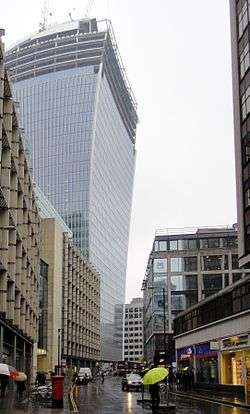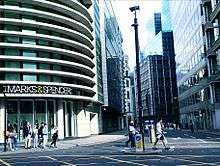Fenchurch Street
Fenchurch Street is a street in London linking Aldgate at its eastern end with Lombard Street and Gracechurch Street in the west. It is a well-known thoroughfare in the City of London financial district and is the site of many corporate offices and headquarters. The name "Fenchurch" derives from the Latin faenum (hay) and referred to hay markets in the area.[1]

To the south of Fenchurch Street and towards its eastern end is Fenchurch Street railway station, a mainline terminus with services towards east London and Essex. Other notable sites include the commercial buildings at 20 Fenchurch Street and Plantation Place.
Streetscape
Fenchurch Street is home to many shops, pubs and offices, including 20 Fenchurch Street, a 525 ft tall skyscraper completed in 2014.

Located at No. 71 is Lloyd's Register, where the annual journal Lloyd's Registry was previously published. The frontage on Fenchurch Street was built in 1901 by Thomas Edward Collcutt and is a Grade II* listed building.[2] The more modern building behind was designed by Richard Rogers and towers above it. This was completed in 1999 and was shortlisted for the RIBA Stirling prize in 2002.
At the street's eastern end and junction with Aldgate is the Aldgate Pump, a historic water pump which has been designated a Grade II listed structure. Further west, Fenchurch Street's junction with Lime Street was formerly the location of a Christopher Wren church, St Dionis Backchurch. First built in the 13th century dedicated to the patron saint of France, it was destroyed during the Great Fire in 1666, later rebuilt by Wren, and then demolished in 1878.[3]
Nearby, the church of St Gabriel Fenchurch also stood on Fenchurch Street at its junction with Cullum Street. A blue plaque outside Plantation Place marks the site opposite where the church once stood before its destruction in the Great Fire.
The western portion of Fenchurch Street formed part of the marathon course of the 2012 Olympic Games.[4][5]
In 2019, a mixed use building of 15 storeys with a publicly accessible roof garden, called One Fen Court, opened at 120 Fenchurch Street.[6][7]
The nearest London Underground stations are Aldgate (just beyond the eastern end of the street), Tower Hill (to the southeast) and Monument (to the west); Fenchurch Street railway station has no direct Underground connection.
The postcode for the street is EC3M.
See also
Nearby streets:
References
- Weinreb et al. 2008, p. 288.
- Listing details, 71 Fenchurch Street, English Heritage accessed 21 Jun 2007
- Smith, A. (1970). Dictionary of City of London Street Names. David & Charles. p. 68. ISBN 0-7153-4880-9.
- "London 2012 marathon men - Olympic Athletics". london2012.com. 3 June 2017. Archived from the original on 30 April 2013. Retrieved 28 July 2012.
- "London 2012 marathon women - Olympic Athletics". london2012.com. 3 June 2017. Archived from the original on 2 May 2013. Retrieved 28 July 2012.
- Wainwright, Oliver (21 February 2019). "Fen Court review - a candy-striped miracle in the central London skies". The Guardian. Retrieved 22 February 2019.
- "Fen Court, London, EC3". CBRE. Retrieved 22 February 2019.
| Wikimedia Commons has media related to Fenchurch Street. |
